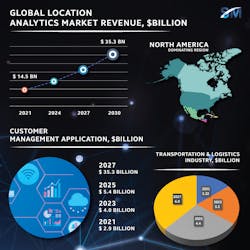Location Analytics Market Forecasts and Drivers
When used in combination with a geographic information system, location analytics is a cinematic method of interpreting and evaluating the data being represented by the data. Both historical and current geographic data can be processed in this way. Businesses that need to track the locations of delivery vehicles and packages in real-time, like courier and postal services, can use real-time location analytics.
The location analytics market was valued at $14.5 billion in 2021 and is expected to see a value of $35.3 billion by 2027. Additional highlights include:
- The customer management application was worth $2.9 billion in 2021, and by 2030 it will be worth USD 7.4 billion.
- Transportation and logistics value in 2021 was $2.3 billion and will be worth $6 billion by 2030.
- Regionally, North America ruled the market with $4.4 billion in 2021. Europe followed with $3.6 billion, and the rest of the world was worth $6.5 billion in 2021.
“The ROI of location intelligence capabilities is significantly associated with how widely they are used across the organization, not just in the traditional use cases associated with maps.”
Why is this relevant? Because location analytics is used in scientific research and disaster mitigation. And telecom providers need to leverage this data to help their customers regain communications services if they are interrupted. Historical data can be visualized on a map to focus flood prevention efforts in areas that have historically been impacted by flooding. Similar rules apply to earthquakes, where it may be necessary to evaluate whether stricter earthquake mitigation requirements are necessary for buildings located in quake-prone areas.
Marketers recognized the benefits of location data early on and continue to be heavy users of it. Location data is widely used (https://www.isemag.com/cande-netdev-ops-gis-open-source-networks/article/14266359/drowning-in-data) for geotargeting and many other marketing applications across market segments, according to a 2020 BCG survey conducted in October (www.bcg.com). Location analytics can help improve sales and marketing campaigns. Businesses can provide their customers with deeper insights more quickly. Interactive maps, visual analytics, and strong intuitive dashboards simplify complex data networks and provide a solid foundation for cross-departmental, cross-organizational, and international collaboration.
Not surprising, applications are expanding beyond marketing, with analytics and operations for real estate, finance, consumer packaged goods (CPG), and urban planning seeing the most growth.
Additional vertical markets tap this data in ways that help drive growth. Three examples include:
- Retailers Use Location Data to Drive Growth.
- Travel Brands Use Location Analytics to Enhance Customer Experience. Location-based information can allow hotels to send welcome messages to end-users as they travel or offer targeted advertising for package deals incentivising them to stay longer. Every travel and tourism website needs an address and location search function because the first step in planning a trip is finding a destination. With the help of potent tourism solutions, customers can find their destination.
- Real Estate Companies Use Data Utilization for Property Interest Levels. The activities around factories, stores, and ports can offer early indicators of a company's performance. Location analytics provides an unprecedented view of the real estate market by analysing real-time mobility data such as foot traffic. This allows real estate agents to adjust prices in economically desirable locations. Home builders can improve construction processes and identify risky areas where an ROI is not as likely.
“…location analytics is used in disaster mitigation. Historical data can be visualized on a map to focus flood prevention efforts in areas that have historically been impacted by flooding. Similar rules apply to earthquake prone areas. The data can help evaluate whether stricter requirements for earthquake mitigation in specific quake-prone areas are necessary.”
Data-Driven Business Strategies Required
Location intelligence enhances the experience of customers and underlying business operations by combining mapping and geospatial data along with a company's internal customer data. Geospatial data is an important part of modern business, and its importance is predicted to grow in the coming years.
The ROI of location intelligence capabilities is significantly associated with how widely they are used across the organization, not just in the traditional use cases associated with maps.
Leaders in an increasing number of industries are turning to location intelligence to keep up with the demand for more individualized customer experiences and the pressure to increase operational effectiveness. They're also meeting the demands of the digital native generation, streamlining global supply chains, increasing sales and revenue, and maintaining their competitiveness in an environment where everything is getting more crowded.
Businesses that deeply dive into data-driven insights will be able to improve their performance. A key component of some of the most prosperous companies in the world today is location intelligence.
REFERENCES AND NOTES
https://www.strategicmarketresearch.com/market-report/location-analytics-market
https://www.esri.com/content/dam/esrisites/sitecore-archive/Files/Pdfs/library/brochures/pdfs/location-analytics-marketing.pdf
https://www.geoapify.com/industries/travel-tourism
https://www.spiceworks.com/marketing/customer-experience/guest-article/three-strategies-for-travel-brands-to-enhance-the-customer-experience/
https://www.insiderintelligence.com/content/how-businesses-use-location-data-effectively
https://www.analytics8.com/blog/unexpected-ways-to-use-location-analytics/
About the Author
Ravi Kumar
Research Analyst, Strategic Market Research
Ravi Kumar is a research analyst with Strategic Market Research. He has more than 5 years of experience in research and consulting services. For more information, please email [email protected] or visit https://www.strategicmarketresearch.com/market-report/location-analytics-market.
Follow Strategic Market Research on Twitter: https://twitter.com/smrstrategic and LinkedIn: https://www.linkedin.com/company/strategic-market-research/

